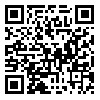Volume 12, Issue 2 (March & April 2021)
BCN 2021, 12(2): 281-290 |
Back to browse issues page
Download citation:
BibTeX | RIS | EndNote | Medlars | ProCite | Reference Manager | RefWorks
Send citation to:



BibTeX | RIS | EndNote | Medlars | ProCite | Reference Manager | RefWorks
Send citation to:
Abdian H, Rezaei M, Eskandari Z, Ramezani S, Pirzeh R, Dadashi M. The Effect of Quantitative Electroencephalography-Based Neurofeedback Therapy on Anxiety, Depression, and Emotion Regulation in People with Generalized Anxiety Disorder. BCN 2021; 12 (2) :281-290
URL: http://bcn.iums.ac.ir/article-1-1742-en.html
URL: http://bcn.iums.ac.ir/article-1-1742-en.html
Hassan Abdian *1 

 , Mazaher Rezaei1
, Mazaher Rezaei1 

 , Zakaria Eskandari2
, Zakaria Eskandari2 

 , Shokoufeh Ramezani3
, Shokoufeh Ramezani3 

 , Reza Pirzeh4
, Reza Pirzeh4 

 , Mohsen Dadashi5
, Mohsen Dadashi5 




 , Mazaher Rezaei1
, Mazaher Rezaei1 

 , Zakaria Eskandari2
, Zakaria Eskandari2 

 , Shokoufeh Ramezani3
, Shokoufeh Ramezani3 

 , Reza Pirzeh4
, Reza Pirzeh4 

 , Mohsen Dadashi5
, Mohsen Dadashi5 


1- Department of Clinical Psychology, Faculty of Medicine, Zanjan University of Medical Sciences, Zanjan, Iran.
2- Department of Clinical Psychology and Addiction Studies, Faculty of Medicine, Zanjan University of Medical Sciences, Zanjan, Iran.
3- Department of Educational Sciences, Faculty of Humanity, University of Mohaghegh Ardabili, Ardabil, Iran.
4- Department of Pschiatry, Faculty of Medicine, Zanjan University of Medical Sciences, Zanjan, Iran.
5- Department of Clinical Psychology, Social Determinants of Health Research Center, Zanjan University of Medical Sciences, Zanjan, Iran.
2- Department of Clinical Psychology and Addiction Studies, Faculty of Medicine, Zanjan University of Medical Sciences, Zanjan, Iran.
3- Department of Educational Sciences, Faculty of Humanity, University of Mohaghegh Ardabili, Ardabil, Iran.
4- Department of Pschiatry, Faculty of Medicine, Zanjan University of Medical Sciences, Zanjan, Iran.
5- Department of Clinical Psychology, Social Determinants of Health Research Center, Zanjan University of Medical Sciences, Zanjan, Iran.
Abstract:
Introduction: Generalized Anxiety Disorder (GAD) is one of the most common anxiety disorders that has significant adverse effects on social functioning, occupational/academic performance, and daily living. This study aimed to evaluate the effect of Quantitative Electroencephalography (QEEG)-based Neurofeedback (NFB) therapy on anxiety, depression, and emotion regulation of people with GAD.
Methods: This research is a quasi-experimental study with a pre-test/post-test/follow-up design and a control group. The study participants were 29 college students with GAD living in Zanjan City, Iran, who were selected using a convenience sampling method. Then, they were randomly divided into two groups of intervention (n=15) and control (n=14). The protocol of NFB therapy was designed based on the QEEG method. The intervention group received QEEG-based NFB therapy for 8 weeks (20 sessions, 2 sessions per week, each session for 45 min), while the control group received no intervention. The samples were surveyed and measured by using a 7-item GAD scale, Emotion Regulation Questionnaire (ERQ), 21-item Depression, Anxiety, and Stress Scale (DASS), and Structured Clinical Interview for DSM (SCID) before and after the intervention and then at a 3-month follow-up. The collected data were analyzed in SPSS software V. 22 using univariate ANCOVA and repeated measures ANOVA.
Results: The within-subjects effect of time (pre-test, post-test, and follow-up) was statistically significant (P=0.031). The intervention group showed significant changes in the post-test and follow-up phases in comparison with the control group. The anxiety and depression levels of patients reduced significantly (P=0.001), and their emotion regulation improved (P=0.001) after the intervention, and they remained unchanged in the follow-up period.
Conclusion: QEEG-based NFB therapy can reduce anxiety and depression and improve emotion regulation in patients with GAD.
Methods: This research is a quasi-experimental study with a pre-test/post-test/follow-up design and a control group. The study participants were 29 college students with GAD living in Zanjan City, Iran, who were selected using a convenience sampling method. Then, they were randomly divided into two groups of intervention (n=15) and control (n=14). The protocol of NFB therapy was designed based on the QEEG method. The intervention group received QEEG-based NFB therapy for 8 weeks (20 sessions, 2 sessions per week, each session for 45 min), while the control group received no intervention. The samples were surveyed and measured by using a 7-item GAD scale, Emotion Regulation Questionnaire (ERQ), 21-item Depression, Anxiety, and Stress Scale (DASS), and Structured Clinical Interview for DSM (SCID) before and after the intervention and then at a 3-month follow-up. The collected data were analyzed in SPSS software V. 22 using univariate ANCOVA and repeated measures ANOVA.
Results: The within-subjects effect of time (pre-test, post-test, and follow-up) was statistically significant (P=0.031). The intervention group showed significant changes in the post-test and follow-up phases in comparison with the control group. The anxiety and depression levels of patients reduced significantly (P=0.001), and their emotion regulation improved (P=0.001) after the intervention, and they remained unchanged in the follow-up period.
Conclusion: QEEG-based NFB therapy can reduce anxiety and depression and improve emotion regulation in patients with GAD.
Keywords: Quantitative electroencephalography, Neurofeedback, Generalized anxiety disorder, depression, Emotion regulation
Type of Study: Original |
Subject:
Clinical Neuroscience
Received: 2020/04/6 | Accepted: 2020/02/10 | Published: 2021/03/1
Received: 2020/04/6 | Accepted: 2020/02/10 | Published: 2021/03/1
Send email to the article author
| Rights and permissions | |
 |
This work is licensed under a Creative Commons Attribution-NonCommercial 4.0 International License. |





